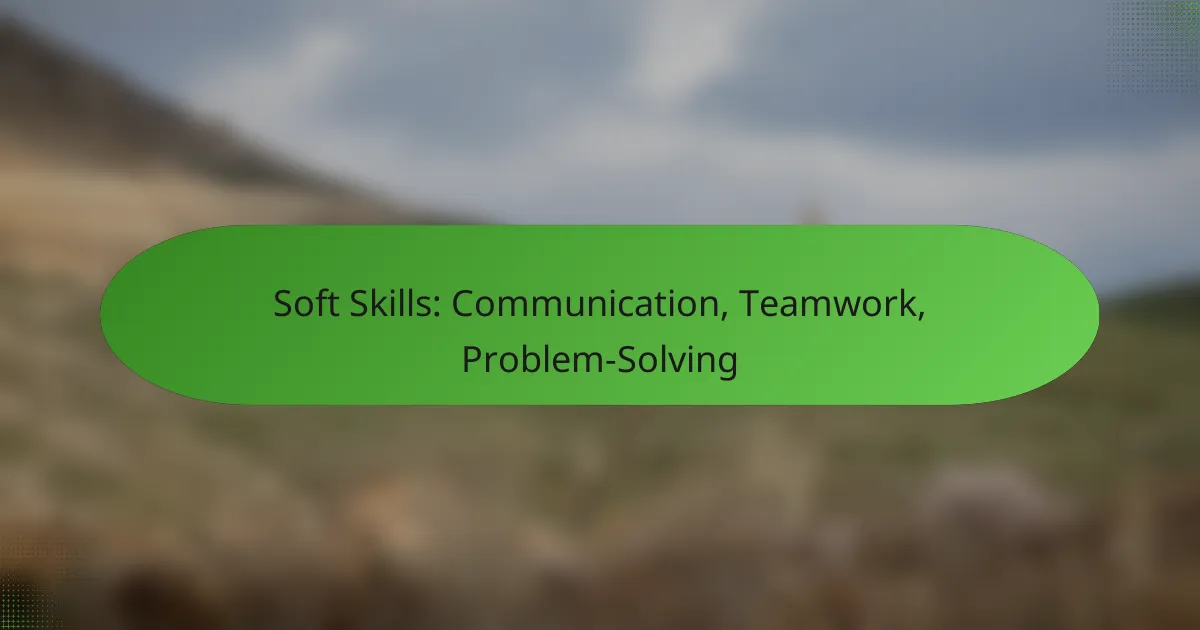Soft skills such as communication, teamwork, and problem-solving are essential for success in the workplace. Effective communication fosters collaboration and enhances team dynamics, while strong teamwork allows individuals to leverage diverse perspectives for better outcomes. Additionally, honing problem-solving skills enables professionals to analyze challenges and implement effective strategies, ultimately driving performance and satisfaction in any work environment.

How to Improve Communication Skills in the Workplace?
Improving communication skills in the workplace involves actively engaging with colleagues, providing clear feedback, and understanding non-verbal cues. These skills foster collaboration, enhance team dynamics, and lead to better problem-solving outcomes.
Active listening techniques
Active listening is crucial for effective communication. It involves fully concentrating on the speaker, understanding their message, and responding thoughtfully. Techniques include maintaining eye contact, nodding to show understanding, and summarizing what the speaker has said to confirm comprehension.
To practice active listening, avoid interrupting and resist the urge to formulate your response while the other person is speaking. Instead, focus on their words and emotions, which can lead to more meaningful conversations.
Effective feedback methods
Providing effective feedback is essential for improving communication. Use the “sandwich” method: start with a positive comment, address areas for improvement, and conclude with another positive note. This approach helps maintain a constructive tone and encourages receptiveness.
Be specific in your feedback. Instead of saying “good job,” specify what was done well, such as “your presentation was clear and engaging.” This clarity helps the recipient understand what behaviors to continue or change.
Non-verbal communication strategies
Non-verbal communication includes body language, facial expressions, and tone of voice, which can significantly impact how messages are received. Be aware of your own non-verbal signals and ensure they align with your verbal messages.
For example, crossing your arms might signal defensiveness, while an open posture can indicate receptiveness. Observing others’ non-verbal cues can also provide insights into their feelings and reactions, enhancing overall communication.
Tools for enhancing communication
Utilizing communication tools can streamline interactions and improve clarity. Platforms like Slack, Microsoft Teams, or Zoom facilitate real-time communication and collaboration, especially for remote teams.
Consider using project management tools such as Trello or Asana to keep everyone informed about tasks and deadlines. These tools help reduce misunderstandings and ensure that team members are on the same page.
Workshops and training programs
Participating in workshops and training programs can significantly enhance communication skills. Look for programs that focus on active listening, feedback techniques, and non-verbal communication. Many organizations offer these resources, which can be tailored to specific workplace needs.
Investing in professional development not only improves individual skills but also fosters a culture of open communication within the team. Encourage team members to share their experiences and insights gained from these programs to reinforce learning.

What Are the Benefits of Teamwork?
Teamwork enhances collaboration among individuals, leading to a variety of benefits that improve overall performance and workplace satisfaction. By working together, team members can leverage their diverse skills and perspectives to achieve common goals more effectively.
Increased productivity
Teamwork often leads to increased productivity as tasks can be divided among members, allowing for faster completion. When individuals collaborate, they can tackle larger projects more efficiently, often resulting in higher output within shorter timeframes.
To maximize productivity, teams should clearly define roles and responsibilities. Regular check-ins can help ensure everyone stays on track and that any obstacles are addressed promptly.
Enhanced creativity
Collaborative environments foster creativity by bringing together different viewpoints and ideas. Team members can brainstorm solutions and innovate in ways that might not be possible individually.
Encouraging open communication and creating a safe space for sharing ideas can significantly enhance creative output. Teams can benefit from structured brainstorming sessions or creative workshops to stimulate innovative thinking.
Improved employee morale
Teamwork can boost employee morale as individuals feel more connected and supported by their colleagues. A strong team dynamic fosters a sense of belonging and shared purpose, which can lead to greater job satisfaction.
To maintain high morale, teams should celebrate achievements, both big and small. Regular team-building activities can also strengthen relationships and create a positive work environment.
Real-world examples of successful teams
Many organizations have thrived due to effective teamwork. For instance, companies like Google and Apple emphasize collaborative projects, resulting in innovative products and services that have transformed industries.
Another example is the healthcare sector, where multidisciplinary teams work together to provide comprehensive patient care. These teams combine expertise from various fields, leading to improved outcomes and higher patient satisfaction.

How to Develop Problem-Solving Skills?
To develop problem-solving skills, focus on understanding the problem, exploring solutions, and implementing effective strategies. This involves a systematic approach that enhances your ability to analyze challenges and devise practical solutions.
Step-by-step problem-solving process
The step-by-step problem-solving process typically includes identifying the problem, gathering information, generating options, evaluating alternatives, and implementing a solution. Start by clearly defining the issue to ensure you address the right challenge.
Once you have a clear understanding, brainstorm potential solutions. Evaluate these options based on criteria such as feasibility, resources, and potential impact. Finally, choose the best solution and create a plan for implementation.
Critical thinking exercises
Engaging in critical thinking exercises can significantly enhance your problem-solving abilities. Activities like puzzles, logic games, and scenario analysis help sharpen your analytical skills and encourage you to think outside the box.
Consider practicing with real-world case studies where you analyze problems and propose solutions. This not only builds your critical thinking but also prepares you for practical applications in your professional life.
Collaboration in problem-solving
Collaboration plays a vital role in effective problem-solving. Working with a diverse team allows for multiple perspectives, which can lead to more innovative solutions. Encourage open communication and brainstorming sessions to leverage the strengths of each team member.
Be mindful of group dynamics; ensure that all voices are heard and valued. This inclusive approach can enhance creativity and lead to more robust solutions that might not emerge in isolation.
Tools for effective problem-solving
Utilizing the right tools can streamline the problem-solving process. Software like mind mapping tools, project management applications, and data analysis programs can help organize thoughts and track progress.
Consider using frameworks such as SWOT analysis (Strengths, Weaknesses, Opportunities, Threats) or the 5 Whys technique to dissect problems systematically. These tools provide structure and clarity, making it easier to navigate complex issues.

What Are the Key Soft Skills Employers Look For?
Employers prioritize several essential soft skills that enhance workplace effectiveness and collaboration. Key among these are communication, teamwork, adaptability, and emotional intelligence, which collectively contribute to a productive work environment.
Communication skills
Effective communication skills involve clearly conveying ideas and actively listening to others. This includes verbal, non-verbal, and written communication, which are crucial for ensuring that messages are understood and interpreted correctly.
To improve communication, practice active listening by summarizing what others say and asking clarifying questions. Avoid jargon when speaking to ensure clarity, especially in diverse teams where language proficiency may vary.
Teamwork abilities
Teamwork abilities refer to the capacity to collaborate effectively with others towards a common goal. This skill is vital in most workplaces, as projects often require input and cooperation from multiple team members.
To enhance teamwork, establish clear roles and responsibilities within the group. Regular check-ins can help maintain alignment and address any conflicts early on. Recognizing and valuing each member’s contributions fosters a positive team dynamic.
Adaptability and flexibility
Adaptability and flexibility are the skills that enable individuals to adjust to changing circumstances and new challenges. In today’s fast-paced work environment, being open to change is essential for personal and organizational growth.
To cultivate adaptability, embrace a mindset of continuous learning and be willing to step outside your comfort zone. Consider scenarios where you might need to pivot your approach and practice responding to unexpected changes positively.
Emotional intelligence
Emotional intelligence is the ability to recognize, understand, and manage your own emotions, as well as those of others. This skill is crucial for building strong relationships and navigating social complexities in the workplace.
To develop emotional intelligence, practice self-awareness by reflecting on your emotional responses and seeking feedback from colleagues. Empathy is also key; try to understand situations from others’ perspectives to foster better communication and collaboration.
